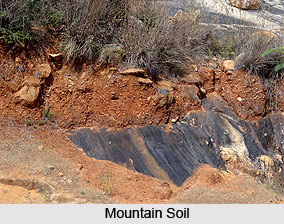 Mountain soils are mainly found in hill slopes and are formed by deposition of organic matter from woodlands and forests. Mountain soils are generally located in the dry and cold districts like Ladakh, Lahaul and Spiti District, Kinnaur District etc. Mountains soils are mostly found in the Himalayan regions, Sikkim, Assam, Arunachal Pradesh and Kashmir and also in the Peninsula, Eastern Ghats and the summits of Sahyadris. There is a huge variety of soils in the Himalaya Mountain ranges and mountain soils are one among such diverse varieties. Further, in the river valleys as well as on the river terraces, alluvial soils are found but across the slopes, one generally comes across soils of different textures. Fine textured soils are mainly found in the river valleys or in the outwash plains. In other parts of these hilly districts, soils are in general stony and shallow but are poor in organic matter.
Mountain soils are mainly found in hill slopes and are formed by deposition of organic matter from woodlands and forests. Mountain soils are generally located in the dry and cold districts like Ladakh, Lahaul and Spiti District, Kinnaur District etc. Mountains soils are mostly found in the Himalayan regions, Sikkim, Assam, Arunachal Pradesh and Kashmir and also in the Peninsula, Eastern Ghats and the summits of Sahyadris. There is a huge variety of soils in the Himalaya Mountain ranges and mountain soils are one among such diverse varieties. Further, in the river valleys as well as on the river terraces, alluvial soils are found but across the slopes, one generally comes across soils of different textures. Fine textured soils are mainly found in the river valleys or in the outwash plains. In other parts of these hilly districts, soils are in general stony and shallow but are poor in organic matter.
Features of Mountain Soils
The basic character of the mountain soils depend on the climate and are mainly found in the warm temperate belt or the cool temperate belt of the Himalaya Mountains. Brown forest soil is mainly found in the warm temperate belt lying at heights ranging from 900 to 1800 metres, which has deciduous forests. This belt comprises enough warmth for decomposition of vegetation. The typical brown forest soil of this zone is rich in humus and is deep. Further, mountains soils are rich in humus, slightly acidic and are fertile. Mountains soils are also deprived in lime and potash content. They are largely used for raising different varieties of crops.
Podzol is the characteristic soil of cool wet temperate zone with coniferous forests. Almost above an altitude of 1800 metres, brown forests soil grades into Podozolised soils. At this belt with Podzol soil, vegetation is comparatively low because of low temperature and thick forests. This mountain soil is a bit highly leached soil and acidic in reaction. It is poorly fertile too. Alpine meadow soil is a dark coloured thin soil mainly found in the Alpine zone of the Himalayan Mountain range. It is basically sandy and contains un-decomposed plants.
The parched, sandy soils include wind-borne loess also. With irrigational facilities these soils are found to render beneficial harvests. The mountain soils embrace peat, meadow, forest and soils. The forest soils can be described as soils in the making. Owing to the extensive variety of fertile soil, India is able to turn out a variety of crops. It is important because this potential can make India not only self-reliant in agricultural produce, but also a leading exporter of countless agricultural products. This would, however depend on scientific management of the soil, their right conservation, evasion of their erosion and upkeep of their fertility through bio-manures, rather than depending wholly on chemical fertilisers. This is obvious from the fact that almost nine million hectares of alluvial soil and seven million hectares of black soil are presently suffering from salinity and alkalinity. Much of it is owes to water logging and unreasonable irrigation. Perceiving the importance of mountain soil as a priceless supply, measures have been taken to resist soil erosion, caused by running water and winds. Conservation of soil is compulsory to guarantee sustained productivity of land. Various types of crops are cultivated on this type of soil like coffee, tea, wheat, maize, barley, tropical fruits and various types of spices.
Mountain soils are deficient in nitrogen content. This mineral is very significant to a healthy soil. Quality and quantity of mountain soil is already compromised as a result of the instable pattern of monsoon rainfall. However, soil formation is quite slow in mountain areas because of the low temperatures. Thus, mountain soils are comparatively thin and are badly anchored.















